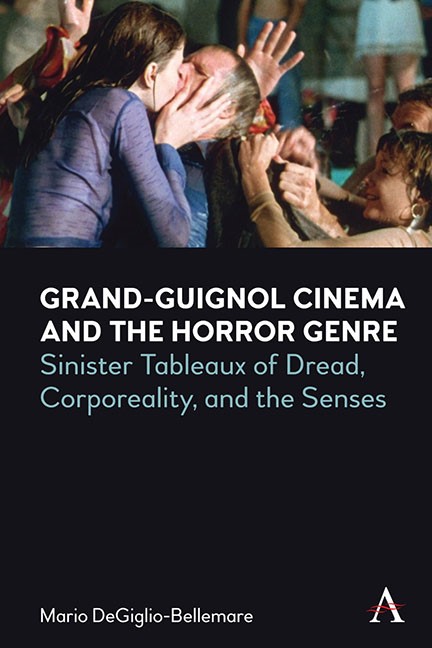Book contents
- Frontmatter
- Dedication
- Contents
- Miscellaneous Frontmatter
- Introduction: Grand-Guignol Cinema and the Senses: Eyes Without a Face, Attractions, Affect and Facial Trauma
- Chapter One The Grand-Guignol Theatre: A Short History of theTheatre and Spatial Ecologies of Dread The Hitch-Hiker and Shivers
- Chapter Two Grotesque Carnivals of “Stubborn” Aurality: Embodied Discourse in Early Talkie Horror Cinema Murders in the Rue Morgue, Freaks, and The Black Cat
- Chapter Three The Sight of Corpses in the Ruins of Modernity: Surgical Sadists under Censorship: The Body Snatcher, and Mad Love, The Blood of the Beasts
- Chapter Four Erotic Abattoirs of Bad Taste: Unproductive Potlatch in Exploitation Cinema: Fascination, Grapes of Death, and Salò, or 120 Days of Sodom
- Chapter Five French Colonial Skinning: Affect and Becoming-Wound in the Cinema of Sensation: Trouble Every Day, Sombre, and In My Skin
- Conclusion: Drag Performativity and Multisensorial Dread Blood and Black Lace and Psycho
- Bibliography
- Index
Chapter One - The Grand-Guignol Theatre: A Short History of theTheatre and Spatial Ecologies of Dread The Hitch-Hiker and Shivers
Published online by Cambridge University Press: 15 November 2023
- Frontmatter
- Dedication
- Contents
- Miscellaneous Frontmatter
- Introduction: Grand-Guignol Cinema and the Senses: Eyes Without a Face, Attractions, Affect and Facial Trauma
- Chapter One The Grand-Guignol Theatre: A Short History of theTheatre and Spatial Ecologies of Dread The Hitch-Hiker and Shivers
- Chapter Two Grotesque Carnivals of “Stubborn” Aurality: Embodied Discourse in Early Talkie Horror Cinema Murders in the Rue Morgue, Freaks, and The Black Cat
- Chapter Three The Sight of Corpses in the Ruins of Modernity: Surgical Sadists under Censorship: The Body Snatcher, and Mad Love, The Blood of the Beasts
- Chapter Four Erotic Abattoirs of Bad Taste: Unproductive Potlatch in Exploitation Cinema: Fascination, Grapes of Death, and Salò, or 120 Days of Sodom
- Chapter Five French Colonial Skinning: Affect and Becoming-Wound in the Cinema of Sensation: Trouble Every Day, Sombre, and In My Skin
- Conclusion: Drag Performativity and Multisensorial Dread Blood and Black Lace and Psycho
- Bibliography
- Index
Summary
In this chapter I present a short history of the Grand-Guignol theatre, not only on the enduring importance of the grand-guignolesque to the horror genre, but as a geographical space with distinctive features. Even though I focus my analysis on the beginnings of the theatre, I am not interested in progress views of history and heterogeneously move into spatial considerations of two films: Ida Lupino’s The Hitch-Hiker (1953) and David Cronenberg’s Shivers (1975). Spatial readings of these films are important because going to the Grand-Guignol theatre produced a particular experience that was at once intimate and claustrophobic. The horror film is often associated, especially in psychoanalytic readings, with past traumas that return to haunt present space, but I want to complicate this reading through a genealogical analysis which is outside, but also interwoven within, dominant readings of the horror genre. The films I discuss construct an aesthetic and sensorial spatial ecology that I call Grand-Guignol cinema. These films generate in the viewer an experience of dread that is based on the notion of the huis-clos or the closed setting: as illustrated with the car in Lupino’s film and the apartment complex in Cronenberg’s version. There is no longer a theatre called “the Grand-Guignol.” There are only traces left behind in the form of plays, interviews and photographs of a place long gone. The small brick-and-mortar theatre finally closed down in 1962, but like a resuscitated corpse on an emergency room gurney, the Grand-Guignol tradition lives on in live and filmed interpretations, collected plays and in scholarly research and conferences. Today, the physical space is currently occupied by the International Visual Theatre (IVT), a company devoted to presenting plays in sign language. The Grand-Guignol is a “legendary theatre,” according to Richard J. Hand and Michael Wilson, “full of myth-making hyperbole, innuendo and mystique” (2002: 33). A short segment from the Italian “mondo” documentary, Ecco (Gianni Proia, 1963), featuring a serial killer, is the only extant footage from an actual Grand-Guignol performance. Rare cinematic images of the actual Grand-Guignol space can be found in Jean Rollin’s first two films, The Rape of the Vampire/ Le Viol du Vampire (1968) and The Nude Vampire/La Vampire Nue (1970), shot after the theatre had officially closed down.
- Type
- Chapter
- Information
- Grand-Guignol Cinema and the Horror GenreSinister Tableaux of Dread, Corporeality and the Senses, pp. 25 - 62Publisher: Anthem PressPrint publication year: 2023

